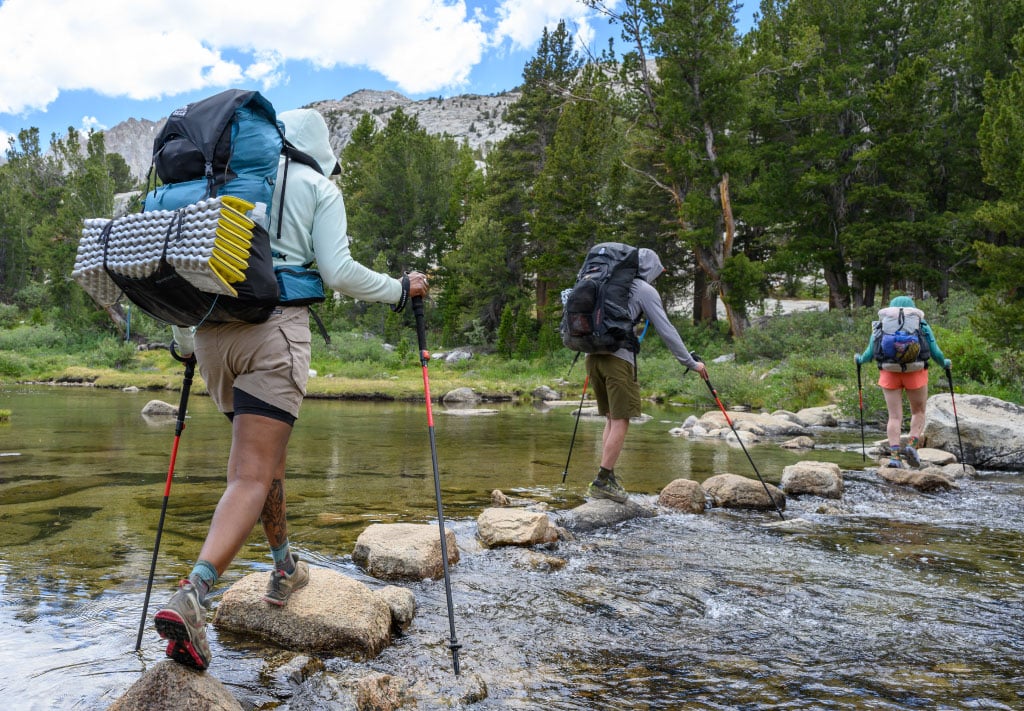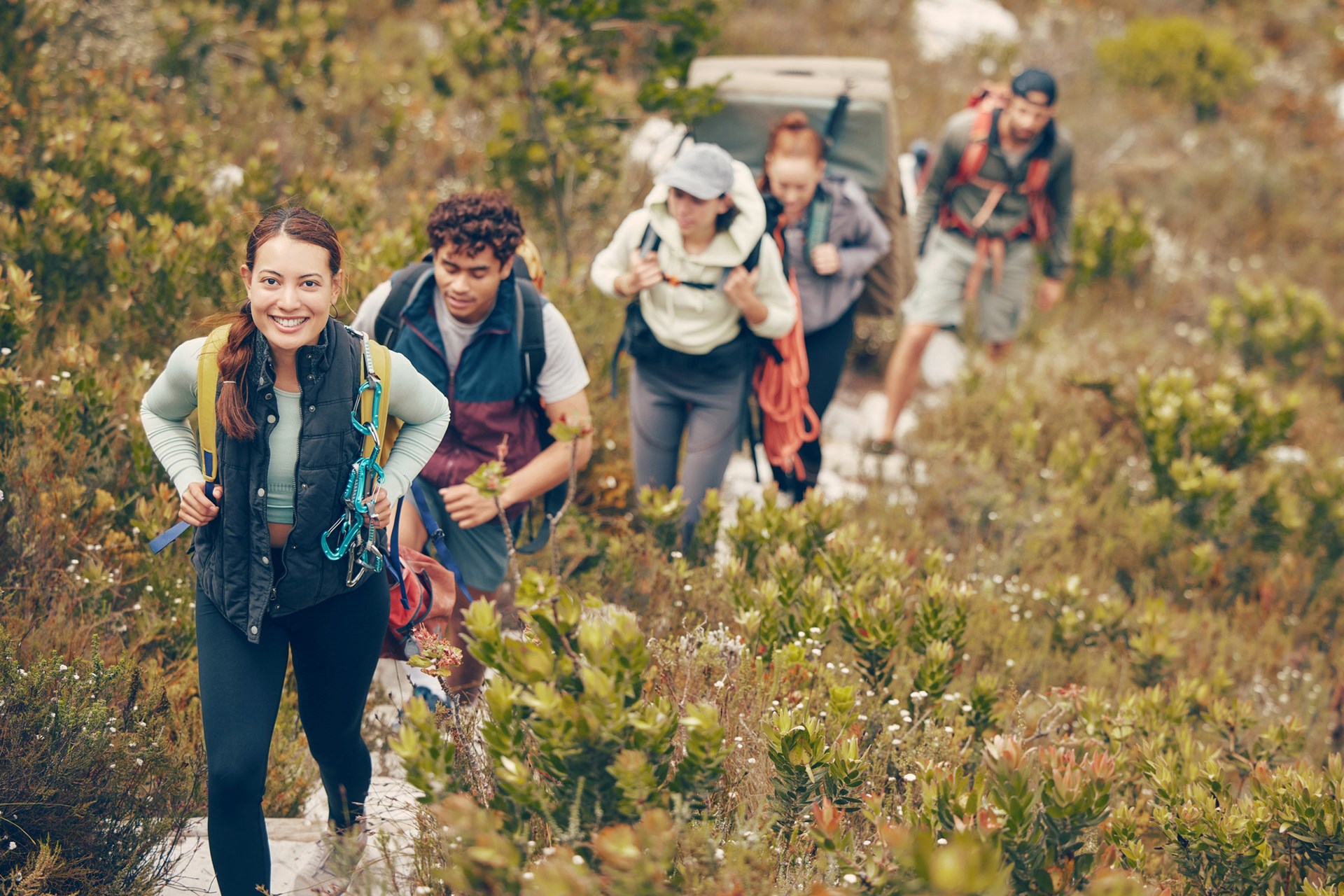How To pack a backpack for hiking, distribute weight evenly, and prioritize essential items. Organize gear by frequency of use, placing frequently accessed items at the top.
Packing a backpack for a hike is both an art and a science, ensuring comfort and accessibility on the trail. Seasoned hikers understand the importance of a well-packed backpack—it can be the difference between a grueling trek and an enjoyable adventure.
A systematic approach, beginning with lightweight gear at the bottom and heavier items near the center of the back, optimizes balance and reduces fatigue. Essential gear like water, snacks, and first aid should be within easy reach. With each item thoughtfully placed, you not only maximize space but also maintain a steady center of gravity. This careful planning not only increases your efficiency on the hike but also prepares you to face the unpredictability of nature with confidence.

Credit: www.discoveringanew.com
Gearing Up For The Trail
Embarking on a hiking adventure requires thoughtful preparation. A well-packed backpack is the backbone of any successful trail journey. It’s more than just stowing gear; it’s about balancing comfort, necessity, and accessibility. Let’s streamline the packing process with expert tips for a joyous hike.
Knowing How to Pack Backpack for Hiking
Selecting a backpack is critical. Invest in a pack that suits your body and the hike’s needs. Measure your torso length and choose a backpack with adjustable straps. Lightweight yet durable materials like nylon or polyester are ideal. Internal-frame backpacks offer better balance and are more compact, which is key for tricky paths. Capacity matters – a 30L backpack works for day hikes, while a 50-70L gear carrier is better for longer treks.
Look for:
- Comfort: Padded straps and hip belts.
- Compartments: Easy access pockets.
- Hydration: Water reservoir sleeve.
- Ventilation: Mesh back panels.
Hiking Essentials for BeginnersEmbarking on your first hiking adventure is an exciting step into the world of outdoor exploration. To ensure a safe and enjoyable experience, having the right gear is crucial. In this guide, we’ll walk you through the hiking essentials for beginners, helping you prepare for a successful and memorable journey.
|
Understanding The Hike Duration And Terrain
Specific trails demand specific gear. Gauge the terrain and climate to pack effectively. For steep inclines, pack light with essentials. Include more water and food for long trails. Cross-referencing your hike’s duration with the terrain helps determine the exact equipment needed.
| Trail Type | Essentials | Optional |
|---|---|---|
| Day Hike | Snacks, water, first-aid kit | Extra clothing layer |
| Mountainous Terrain | Map, compass, trekking poles | GPS device |
| Overnight | Sleeping bag, shelter, headlamp | Camp stove |
Always remember safety comes first. For rugged trails, include a helmet. Feel confident, as the right gear fosters a great hiking experience.
Essentials First: What To Pack
Packing your backpack for a hike is like putting together a puzzle. Each piece is essential. The trick lies in knowing what to pack first. Focus on the core items that will keep you safe and comfortable. From navigating the terrain to dealing with an emergency, here’s how to prioritize.
The Ten Essentials Checklist
Start with these must-have items. They could save your life.
- Navigation: Map, compass, GPS device
- Headlamp: Plus extra batteries
- Sun protection: Sunglasses, sunscreen, hat
- First aid: Preassembled kit, insect repellent
- Knife: Also repair kit, gear tape
- Fire: Matches, lighter, stove
- Shelter: Tent, bivy sack, space blanket
- Extra food: Beyond the minimum expectation
- Extra water: And a way to purify it
- Extra clothes: For the worst possible conditions
Weather-specific Gear
Your destination’s weather guides the extras. Pack accordingly.
| Condition | Gear |
|---|---|
| Cold | Insulated jacket, warm hat, gloves |
| Wet | Waterproof clothing, quick-dry fabrics |
| Sunny | Breathable fabrics, brimmed hat |
| Windy | Windbreaker, chapstick, goggles |
| Snowy | Insulated boots, gaiters, sunglasses |
Weight Distribution Tactics
Choosing the right tactics for weight distribution in your hiking backpack is key. A well-balanced pack reduces strain and increases stability. It can mean the difference between a tiresome hike and an enjoyable outdoor adventure. Let’s dive into how to distribute weight efficiently for your next hike.
Balancing Your Load
A balanced load is vital for comfort and energy conservation. Imagine your backpack divided into three sections: bottom, middle, and top. Heavy items like water reservoirs belong in the middle, close to your spine. This approach keeps the weight centered and minimizes the load’s pull.
- Bottom zone (sleeping gear): Items used less frequently, such as a sleeping bag.
- Middle zone (heaviest items): Stove, food, hydration system.
- Top zone (light gear): Clothing and light snacks.
Distribute items side-to-side to avoid lopsidedness. Ensure the heaviest gear doesn’t sag to one side. Your backpack should feel like an extension of your body.
Packing For Accessibility And Comfort
Pack smart to access what you need without unpacking everything. Frequently used items, like sunscreen and a hat, should be within reach. Place them in your backpack’s top or side pockets.
- Top pocket: Sunglasses, snacks, a map, and a compass.
- Side pockets: Water bottles, a rain cover, and trekking poles.
- Front/hipbelt pockets: A camera, phone, and small tools.
Comfort comes from proper adjustment. Tighten the straps to keep the pack close. Adjust the load throughout your hike to maintain balance and comfort.
| Section | Items to Pack | Notes |
|---|---|---|
| Top | Clothes, Snacks | Must-be-reachable items. |
| Middle | Heavy gear | Keep close to the spine for balance. |
| Bottom | Sleeping bag | Low frequency use. |
Once packed, lean forward slightly to test the balance. A good pack allows you to walk naturally without straining.
Food And Hydration Strategies
Packing the right fuel for your hiking adventure is crucial for peak performance. Nourish your body and sustain your energy with well-thought-out food and hydration strategies. Let’s break down what makes up the best snacks for the trail and compare hydration pack and water bottle options.
Nutrient-rich Foods For Energy
Energy-boosting snacks are vital for long hikes. Your body works hard, and it needs powerful fuel. A balance of carbs, protein, and fats keeps you going. Pack foods that don’t spoil and provide quick, sustained energy.
- Nuts and seeds: Compact and packed with protein
- Whole grain wraps: Loaded with carbs for energy
- Dried fruits: Natural sugars for a quick boost
| Snack Type | Energy | Shelf Life |
|---|---|---|
| Nuts and Seeds | High | Long |
| Whole Grain Wraps | Medium | Short |
| Dried Fruits | High | Long |
Hydration Packs Vs Water Bottles
Staying hydrated is essential. But which is best, a hydration pack or water bottles? Each option has its benefits.
Hydration Packs:
- Convenient for sipping while walking
- Hands-free
- Usually holds more water
Water Bottles:
- Easy to refill
- Simple to track how much you drink
- Can be more durable
| Feature | Hydration Pack | Water Bottle |
|---|---|---|
| Volume | 2-3L | 0.5-1L |
| Accessibility | High | Medium |
| Durability | Medium | High |
Consider the length of your hike, water sources on the trail, and personal preference. Choose the hydration method that suits your needs the best.
Safety And Navigation Tools
Preparing for a hike is not just about packing snacks and water. Safety and navigation are crucial to any outdoor expedition. A well-packed backpack ensures you’re ready for unexpected situations. Let’s focus on the essential safety and navigation tools you should include in your hiking gear.
Technology Vs Classic Navigation Gear
Modern tech complements traditional tools on the trail. Both have their place in your pack. GPS devices offer real-time location tracking, while maps and compasses don’t rely on batteries. Let’s compare.
- GPS Units – Provide location at a glance.
- Compass – Always ready, needs no power.
- Maps – Detail terrain, trails, and landmarks.
- Smartphones – Useful apps but drain quickly.
Always carry a map and compass as backups. They can save your hike if technology fails. Aim for a balance between the two types of gear.
Emergency And First Aid Must-haves
Accidents happen. Being prepared can mean the difference between a small hiccup and a dire situation. Your first aid kit should be tailored to your hiking environment.
| First Aid | Emergency Tools |
|---|---|
|
|
Inspect your first aid kit regularly. Replace used or outdated items. Know the basics of how to use each item. Don’t forget personal medications.
Emergency tools signal for help and keep you warm. A whistle is louder than your voice. A reflective blanket can shield you from cold. Signal mirrors alert rescuers in daylight.

Credit: www.msrgear.com
Leave No Trace: Eco-friendly Packing
When packing a backpack for hiking, it’s not just about what you pack but how you pack it. Eco-friendly packing is central to the Leave No Trace principles. It ensures that the beautiful trails and landscapes remain untouched for others to enjoy. The goal is to minimize our impact on the environment, maintaining its natural state.
Minimizing Packaging And Waste
Before you even start loading your backpack, consider the packaging of your items. Too much packaging leads to unnecessary waste.
- Choose items with minimal packaging.
- Repackage food into reusable containers.
- Plan meals to avoid leftovers.
- Use biodegradable soap for cleaning.
- Carry a small trash bag for any unavoidable waste.
Stick to essentials to avoid carrying what you don’t need. Always pack out everything you pack in, leaving nothing behind.
Reusable And Sustainable Options
Investing in reusable gear cuts down on waste and can be more cost-effective in the long run.
| Single-Use Items | Eco-Friendly Alternatives |
|---|---|
| Plastic water bottles | Refillable water containers |
| Disposable batteries | Rechargeable batteries or solar chargers |
| Plastic bags | Cloth sacks or silicon bags |
| Paper maps | Digital trail apps (be sure to have a power source!) |
Choose items made from sustainable materials. This reduces environmental impact.
By packing smart, you contribute to preserving the natural beauty of hiking trails for future generations.
Packing Practicalities: Tips And Tricks
Welcome to the world of packing practicalities, where mastering the art of organizing your backpack can make all the difference on a hiking trip. In this section, we’ll cover some essential tips and tricks that ensure a comfortable journey without leaving behind anything important. From weatherproofing your gear to optimizing space, these strategies will have you packing like a pro in no time.
Utilizing Packing Cubes And Compression Sacks
Packing cubes and compression sacks are real game-changers. They not only organize your items but also compress clothes to save space. Here’s how they can revolutionize your backpack:
- Categorize your items: Use different cubes for clothes, electronics, and snacks.
- Easy access: Grab what you need without rummaging through your whole bag.
- Space savers: Compression sacks reduce the volume of your sleeping bag and jackets.
The Roll Vs Fold Debate
The way you arrange your clothes in your backpack can impact how much you can carry. Many hikers are divided between rolling and folding. Let’s delve into both methods:
| Rolling Clothes | Folding Clothes |
|---|---|
| Minimizes wrinkles | Traditional method |
| Maximizes space | Better for formal wear |
| Quick to pack and unpack | Leaves clothes flat |
Experiment to see which method suits your packing style and type of clothing best. Some hikers prefer a combination of both rolling and folding to fit their needs.

Credit: koa.com
Final Checklist And Pre-hike Prep
Before stepping out the door, a thorough check ensures a safe and enjoyable hike. A final sweep through your gear and personal readiness can make a world of difference. Here’s what to tick off.
Double-checking Gear Before Departure
Every item has a purpose on the trail. It’s time to confirm nothing is missing.
- Backpack – Ensure straps and zippers work.
- Navigation tools – GPS and maps in reach?
- Water and food – Is your supply adequate?
- Clothing – Packed for weather changes?
- Tent and sleeping gear – All components present?
- First-aid kit – Stocked with essentials?
- Multi-tool and gear repair kit – Ready for use?
- Headlamp and batteries – Fully charged or new?
A quick trial pack can reveal missing items.
| Category | Checked |
|---|---|
| Shelter | ✓ |
| Hydration | ✓ |
| Nutrition | ✓ |
| Clothing | ✓ |
| Safety | ✓ |
| Tools | ✓ |
| Lighting | ✓ |
Mental And Physical Readiness
Body and mind should be primed for the trails ahead. Here’s a quick rundown for self-assessment:
- Physical health – Are you feeling well?
- Fitness level – Can you handle the hike’s demands?
- Mindset – Prepared for challenges?
- Knowledge of the trail – Researched the route?
- Emergency plans – Do you know what to do?
Ensure rest is adequate and hydration starts before hitting the trail.
Frequently Asked Questions For How To Pack Backpack For Hiking
How Do I Organize My Hiking Backpack?
Distribute weight evenly, placing heavy items near your back and centered. Keep essentials accessible in top or side pockets. Balance gear appropriately to maintain comfort. Use compression straps to secure items and reduce pack movement. Group similar items in sacks for easy retrieval.
What Order Do You Pack Hiking Backpacks?
Place heavy items close to your back, centered between your shoulder blades. Pack mid-weight items around these. Lighter gear belongs at the bottom, with frequently used items at the top or in external pockets. Balance weight evenly on both sides.
How Do You Pack A Backpack Most Efficiently?
Start by placing heavy items near your back for balance. Distribute mid-weight items evenly around the backpack. Keep essentials within easy reach at the top or in external pockets. Fill gaps with small, light items. Lastly, adjust the straps for comfort and secure load distribution.
What Are The Tips On How To Prepare Your Backpack In Hiking?
Select a comfortable backpack. Prioritize essentials: navigation, water, food, and first-aid. Distribute weight evenly with heavier items centered. Pack layers for changing weather. Keep frequently used items accessible.
Conclusion
Packing your backpack effectively can make or break your hiking experience. Remember to balance weight, prioritize essentials, and leave space for snacks. Smart packing not only boosts comfort but also enhances safety on the trail. So, gear up thoughtfully and embark on your adventure with confidence.
Happy hiking!

